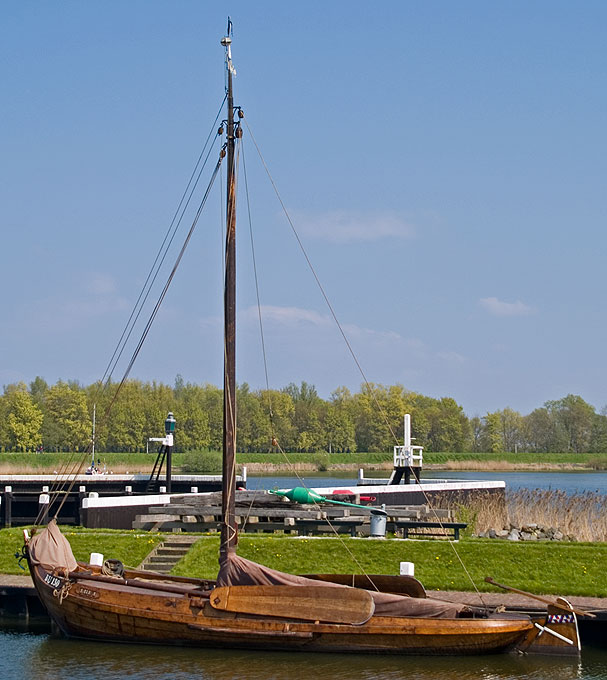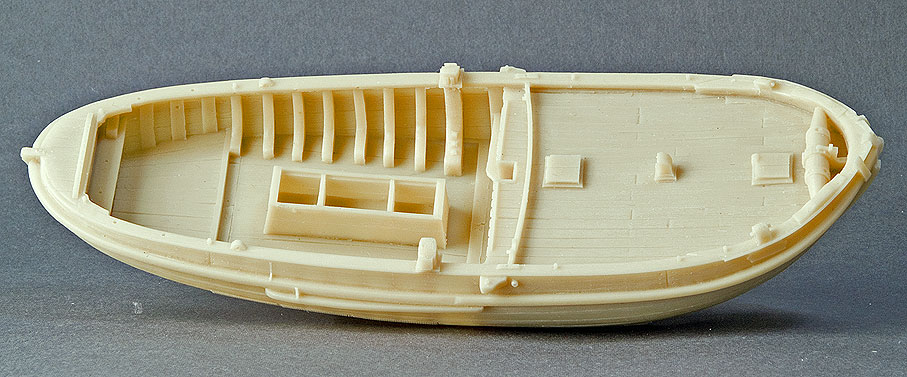I realise that this forum is mainly concerned with naval ships. However, while my work on SMS WESPE (
http://www.maritima-et-mechanika.org/maritime/models/wespe/wespeclass.html) has been interrupted for various reasons (relocation to a different country, marriage) I started this project in a sort of nostalgia of my time in the Netherlands. As building techniques etc. are still the same, I thought this project might interest the community here too.
 A Botter in the Zuiderzeemuseum (Enkhuizen, The Netherlands)History and context
A Botter in the Zuiderzeemuseum (Enkhuizen, The Netherlands)History and contextLooking at old maps it is amazing to see how land and water intertwined once in the northern part of the Netherlands, Noord Holland and Friesland in particular. It is even more so, when one drives through Noord Holland and reminds oneself that this once was a patchwork of islands and shallow stretches of sea. The Dutch fought - and continue to fight - the sea and at the same time a good part of the populations lived off the sea. The Zuiderzee (
http://en.wikipedia.org/wiki/Zuiderzee) once was a vast bay of the North Sea, reaching deep into the country, nearly down to Amsterdam. It served as throughfare for transport and as a rich fishing resource. However, pressure on the scarce land was high and the sea was a constant menace to the low-lying shores and islands. As part of their struggle against the sea, the Dutch dammed up the bay by a large dike, the Afsluitdijk (
http://en.wikipedia.org/wiki/Afsluitdijk), completed in 1933. This put an end to much of the fisheries. The already in its southern part brackish Zuidezee finally turned into a large freshwater lake, the Ijsselmeer.
Over the course of history there have been various types of sailing fishing vessels with numerous local variants. The best-known is probably the Botter (and its larger variant Kwak). At one stage it was estimated that there were over 1000 in operation at the end of the 19th century. The places around the Zuiderzee with the most botters were Enkhuizen, Volendam/Edam, Monickendam, Marken, Bunschoten and Urk. Spakenburg was an important building place.
Man's tools to win a lifelihood constantly change and are being adapted to changing circumstances, new needs and fashions as well. Thus methods of fishing evolved in order to increase efficiency and in response to changes to the fishing grounds and other environmental circumstances that influenced the availability of the resource 'fish'. The history of the botter is not easy to trace as no artefacts have survived and artistic renderings are not so reliable bevore say the late 18th century. As with all small boats, they were built without any drawings well into the 20th century. The botter or its somewhat larger version the Kwak as we know it today developed over the past two hundred years.
Sizes vary, but a typical botter has a keel of about 34 feet long.
SourcesThere are quite a number of comprehensive printed works on the botter and its history (see below). These include also drawings. Some original drawings are preserved in various museums in the Netherlands. However, like so many traditional small boats, botters were usually built without any drawings. The museums also preserve various model built from about the early 19th century onward. There are also surviving quite a number of original botters, the oldest being from the last quarter of the 19th century.
These boats survived because they have been adapted as pleasure craft. Obviously a lot of concessions had to be made in this case to accomodate the modern leisure-boaters and therefore these boats are not useful for a reconstruction. In more recent years some of these have been reconverted into a state that is more like their original workday appearance. Also, from the end of the 19th century onward some botters had been built als pleasure craft for private owners. They usually deviate somewhat from the work boats and are often fitted with a cabin, as is found e.g. on boeiers.
The Zuiderzeemuseum (
http://www.zuiderzeemuseum.nl/home/?language=en) in Enkhuizen preserves a late botter in its boat-hall. The Zuiderzeemuseum also has a large collection of ship- and boatmodels, including several botters. Some of the models appear to be contemporary, while others have been built in more recent times.
The ModelThe model is based on the resin kit produced by Artitec (
http://www.artitec.nl) in 1:90 (HO) scale. This company has developed a real mastery in casting complex and large resin parts. In addition to the hull, the kit contains castings for the mast and spars, for rigging blocks and, somewhat strangely perhaps, the taken-down sails. Of course, these kits are mainly meant as accessories for model railway layouts and people not knowing a lot about these craft. The kit also contains a small fret of etched parts, mainly for the ironwork of the rigging. While the etched parts are well made as such, they are for the most part not really useful for representing the forged ironwork. For instance, masthoops are, of course, flat in the horizontal direction, while they should really be short tubes. Other parts simply lack the needed plasticity. Hence most of the etched parts will not be used. Similarly, the cast rigging blocks will be replaced by home-made ones and 'real' sails will be made. I bought the kit 'second hand' and the at some stage the characteristic high stem head was broken off and a new one will have to grafted on. Various other details will be improved for better definition of the shapes. Although the casting is well made, there are certain limitations due to the casting process. A company policy of Artitec is to limit the number of parts and to cast-on as many details as possible. Thus for instance the spill is cast onto the foredeck. There are limitations to undercuts in the silicone rubber molds, hence the barrel is not completely free. I shall have to remove the material underneath the barrel using a scalpel etc.
 The main cast resin item, the botter’s hull
The main cast resin item, the botter’s hullNot only are Artitec masters in casting kits, but also in painting them as is evidenced for instance by the diorama of the Texel Roadsted (
http://www.dereedevantexel.nl) and models in various other museums around the Netherlands.
To be continued ....
wefalck



